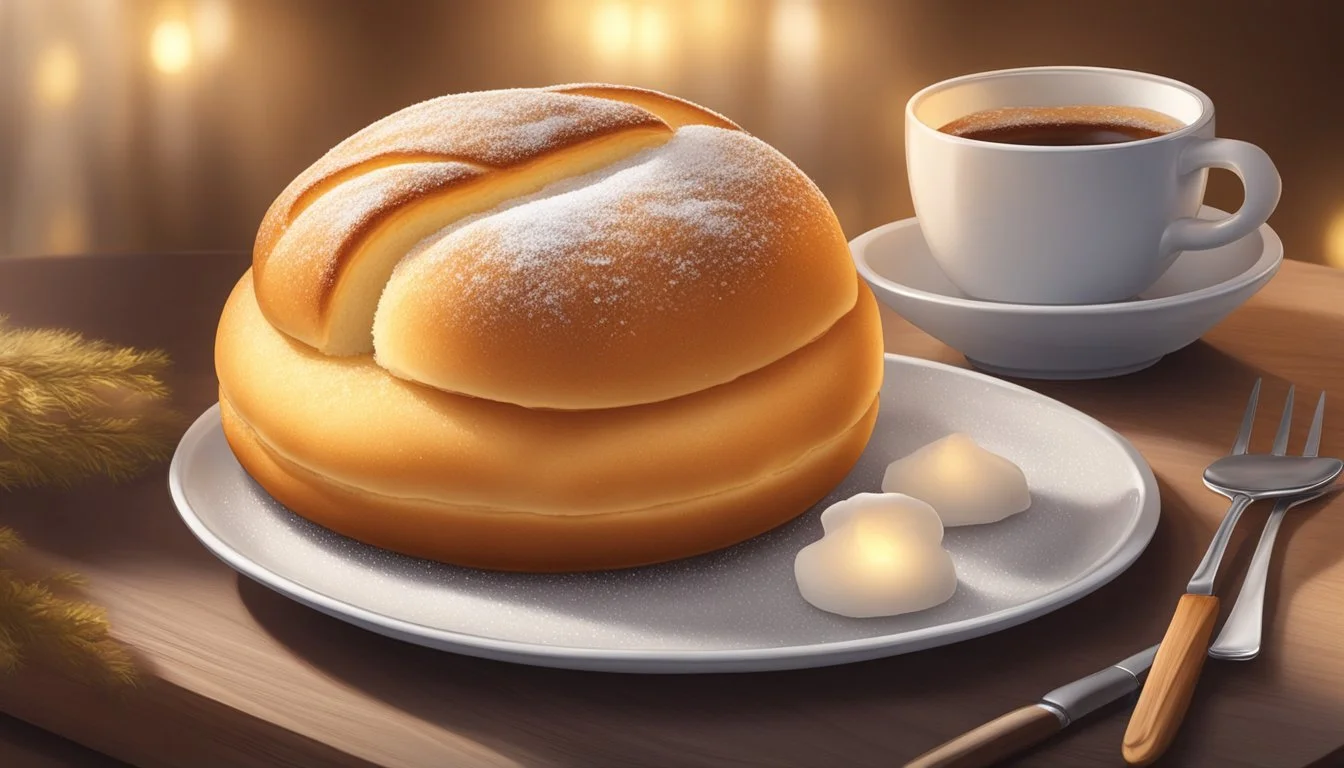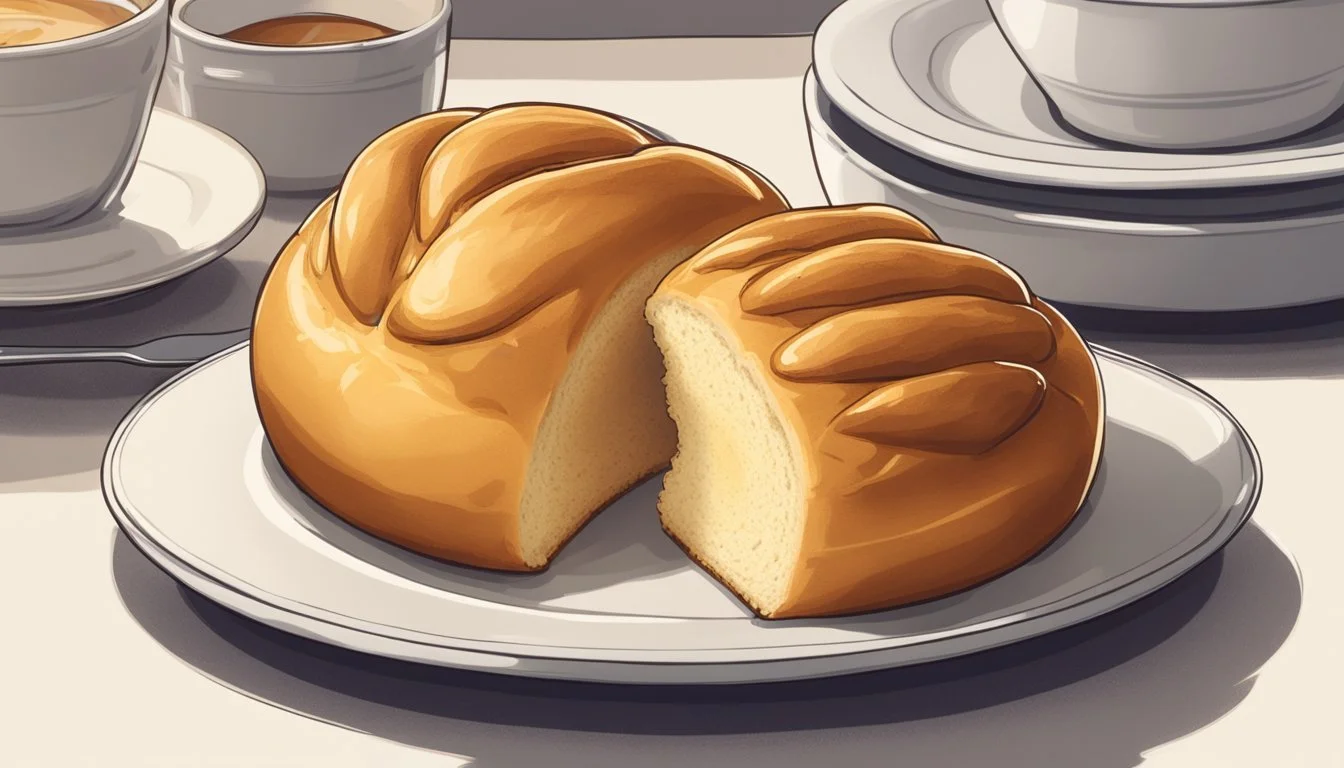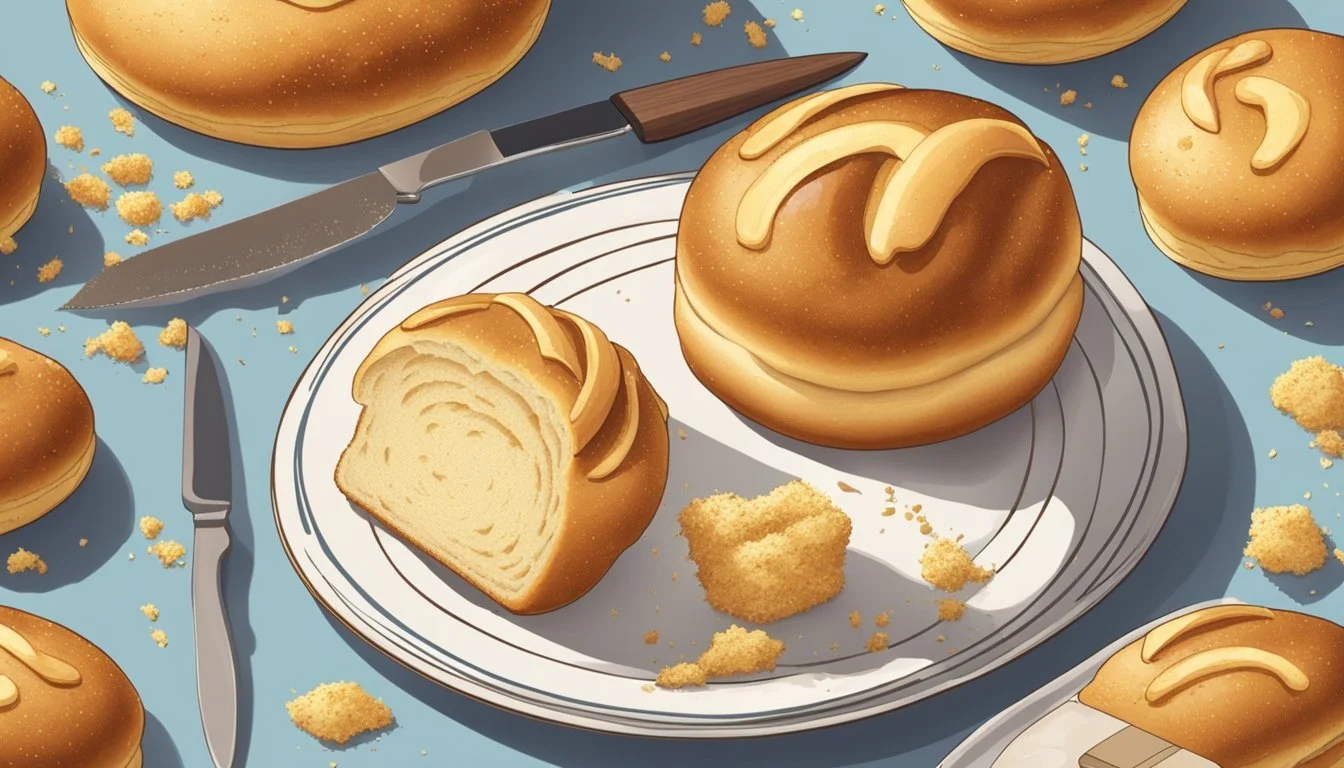How do you eat a brioche bun:
Mastering the Art of Savoring this Butter Rich Pastry
Brioche buns, with their rich and tender crumb, offer a delectable option for various meals, from breakfast to dinner, and even as a base for desserts. Recognized for their golden hue and the glossy sheen on top, brioche is a pastry of French origin that is akin to a highly enriched bread (how long does bread last?). The high egg and butter (how long does butter last?) content give brioche a notably rich and tender texture, which makes it a versatile choice that pairs well with both sweet and savory counterparts.
While brioche can be enjoyed on its own, its buttery flavor and soft texture are enhanced when lightly toasted. A toasted brioche bun can be the foundation of a fulfilling breakfast sandwich, perhaps with a spread of fruit jam or even a more substantial filling like eggs and bacon. For dinner, brioche serves as an excellent vessel for gourmet burgers, given that its slight sweetness complements the savoriness of meats and the tang of condiments.
Beyond savory applications, brioche buns can be transformed into sumptuous desserts. Their absorbent nature makes them ideal for bread puddings or as a twist on traditional French toast, soaking up custards (how long do custards last?) and syrups for a delightful treat. Though brioche is not typically highlighted for its nutrition information, it should be noted that due to the ingredients, it is energy-dense, providing a source of carbohydrates and fats that help fuel one's day when eaten in moderation.
Origins and Characteristics of Brioche
Brioche is a rich, versatile bread rooted in French culinary tradition, distinguished by its high butter and egg content. Its unique flavor and texture make it equally suited to sweet and savory applications.
What Is Brioche?
Brioche is a type of French bread that stands out due to its enriched dough, which includes a generous amount of eggs and butter. Originating from France, brioche holds a special place in French cuisine and is often associated with luxury and indulgence.
Texture and Flavor Profile
The texture of brioche is soft and tender, with a notable lightness and slight puffiness. It has a fine, delicate crumb which is achieved through the high proportion of fats from the eggs and butter. In terms of flavor, brioche is slightly sweet with a rich, buttery taste that is subtly aromatic, distinguishing it from other types of bread.
Nutritional Highlights
Brioche, while rich in flavor, generally contains the following per average slice (approximately 30 grams):
Calories: 100-140
Fat: 3.5-5 grams
Carbohydrates: 15-20 grams
Protein: 2-4 grams
It is important to note that brioche is higher in fats and calories than many other breads due to its enriched dough. Although nutritionally dense, it should be enjoyed in moderation as part of a balanced diet.
Brioche Bun Ingredients
In crafting brioche buns, the selection and balance of ingredients are crucial for achieving their signature light, rich texture and subtle sweetness. From the yeast that allows the dough to rise to the fats that give it a tender crumb, each component plays a pivotal role.
Key Ingredients for Brioche Buns
The fundamental ingredients for brioche buns include:
Flour: The base of the dough, typically all-purpose or bread flour, for structure and gluten development.
Eggs: Essential for richness and color; eggs also provide structure and leavening.
Unsalted Butter: Adds flavor and tender texture; it should be at room temperature to integrate smoothly into the dough.
Sugar: A small amount is used to enhance flavor and assist with browning.
Salt: Balances sweetness and strengthens the dough's gluten structure.
Milk: Often included for tenderness and to activate yeast.
Yeast: The leavening agent that causes dough to rise, creating a light and fluffy texture.
Understanding the Role of Yeast
Yeast is a critical ingredient in brioche buns, serving as a leavening agent that ferments sugars and causes the dough to rise. It is generally activated in a warm, sugary milk mixture until frothy before being added to the dry ingredients.
The Importance of Fat Content
The fat content in brioche buns, derived from eggs and especially from unsalted butter, is what gives them their characteristic rich flavor and tender crumb. The butter must be at room temperature to be evenly distributed throughout the dough. The higher fat content differentiates brioche from other breads, lending a soft and luxurious mouthfeel.
Baking Techniques
When baking brioche buns, achieving the ideal texture and flavor relies on meticulous kneading, careful proofing, and attentively monitored baking. Here are key techniques for each stage.
Kneading and Developing Dough
For brioche dough, the kneading process is critical to develop gluten, which gives the buns their characteristic smoothness and elasticity. One should use a stand mixer with a dough hook attachment to steadily knead the dough until it's smooth and pulls away from the bowl. This typically takes about 10 to 15 minutes on a medium speed. The dough should be slightly tacky, but not sticky, which may require occasional scraping down of the bowl. A kitchen scale can ensure precise ingredient measurements for consistency.
Proofing Process for Brioche
After kneading, the brioche dough needs to proof until it doubles in size, which can take 1 to 2 hours in a warm, draft-free environment. During this stage, the active dry yeast ferments, causing the dough to rise. It's best to cover the dough with a kitchen towel to prevent drying. After the first rise, punch down the dough gently on a floured work surface and shape it for a second, shorter proofing to ensure a delicate crumb.
Baking Tips for the Perfect Crust
Once shaped and proofed, preheat the oven to the temperature specified by the recipe — commonly 350 degrees Fahrenheit. Arrange the buns on a baking sheet lined with parchment paper, allowing space for expansion. An egg wash can be applied for a shiny, golden brown crust. The buns are baked until they are uniformly colored and sound hollow when tapped on the bottom. Monitoring the oven temperature with an external thermometer can help in baking the brioche to perfection.
Variations of Brioche Buns
Brioche buns are versatile and can be found in multiple variations to suit different tastes and uses, from classic recipes to inventive, flavor-packed options.
Types of Brioche Buns
Brioche buns come in various sizes and shapes to complement a range of dishes. The classic brioche bun is often soft, light, and slightly sweet, available in large sizes ideal for hamburgers or smaller dimensions for sliders. Whole wheat and whole grain options offer a heartier texture and a more robust flavor, catering to those seeking a nutritious alternative without sacrificing the distinctive brioche richness.
Seeds and Toppings
Seed toppings add texture and flavor to brioche buns, elevating them beyond their simple elegance. Common toppings include:
Sesame Seeds: Adds a subtle, nutty taste and a delicate crunch.
Poppy Seeds: Offer a slight crunch and an earthy tone to the buns.
Such toppings not only enhance the flavor profile but also contribute to the bun's aesthetic appeal when presented as part of a dish.
Sweet Vs. Savory Variations
Brioche buns are distinctive for their ability to swing between sweet and savory applications:
Sweet Variations: Often include additions such as cinnamon or fruit-based toppings like jam—with flavors ranging from raspberry to blueberry—creating a perfect match for breakfast or dessert options.
Savory Variations: They may incorporate ingredients such as cheese or ham inside the dough or as toppings, making them an excellent choice for sandwiches (What wine goes well with sandwiches?) or as an accompaniment to meals.
Whether one prefers their brioche paired with a juicy burger or as a base for a rich, sweet treat, the breadth of variations available ensures a brioche bun for every palate.
Serving and Pairing Suggestions
Brioche buns are versatile in their use, enhancing both sweet and savory culinary creations with their rich, buttery texture. Whether utilized for delightful breakfast options or as a sophisticated sandwich base, their unique texture and taste open the door to multiple pairing possibilities.
Popular Uses for Brioche Buns
Sandwiches and Burgers: Brioche buns serve as an excellent base for gourmet burgers and upscale sandwiches. Their sturdy yet tender crumb holds up well against juicy hamburger patties and a variety of toppings.
Breakfast Creations: For a sumptuous start to the day, one can't go wrong with brioche buns as part of French toast or as an accompaniment to eggs Benedict.
Accompaniments and Spreads
Jams and Sweet Spreads: The sweetness of brioche pairs beautifully with fruit jams and spreads, making it an ideal complement to a range of breakfast dishes or desserts.
Savory Options: For a more robust flavor, brioche can be enhanced with cured meats (What wine goes well with cured meats?), smoked salmon, or a drizzle of hollandaise sauce.
Transforming Leftover Brioche
Dessert Applications: Leftover brioche is perfect for creating bread puddings, trifles, or even as a base for a deconstructed dessert sandwich.
Reinvented Breakfast: Transform day-old brioche buns into an indulgent French toast or bread-based quiche filling, ensuring no crumb goes to waste.
Recipes and Preparation Tips
When it comes to crafting the perfect brioche bun, the devil is in the details—from the selection of simple ingredients to the intricacies of technique that result in a delicious, homemade bun.
Classic Brioche Bun Recipe
Ingredients:
3 cups all-purpose flour
2 tablespoons granulated sugar
1 packet (2 1/4 teaspoons) active dry yeast
3 large eggs
1/4 cup warm milk
12 tablespoons unsalted butter, room temperature
1 teaspoon salt
Egg wash (1 egg beaten with 1 tablespoon milk)
Activate the yeast: Dissolve sugar and yeast in warm milk and let it sit for 5-10 minutes until frothy.
Combine dry ingredients: In the mixer's bowl, whisk together flour and salt.
Form the dough: To the dry ingredients, add the yeast mixture and eggs. Using a dough hook, mix on low speed until a dough forms.
Add butter: Incorporate butter one piece at a time, ensuring each is mixed in before adding the next.
Knead: Continue to knead until the dough is smooth and elastic.
First rise: Cover the dough with a towel and let it rise in a warm place for 1-2 hours, or until doubled in size.
Shape buns: Divide the dough into equal portions, shaping each into a ball. Place on a baking sheet lined with parchment paper.
Second rise: Allow buns to rise, covered, for another 1-2 hours.
Preheat oven: Set the temperature to 375 degrees F (190 degrees C).
Apply egg wash: Brush the buns with egg wash for a shiny, golden finish.
Bake: Place the buns in the oven and bake for 15-20 minutes or until golden brown.
Cool: Let the buns cool on a wire rack before serving.
Recipe Notes: Ensure all ingredients are at room temperature to achieve the best rise and flavor in your brioche.
Tips for Making Brioche at Home
Ingredient temperature: Ingredients should be at room temperature to ensure optimal mixing and rising. This includes eggs, milk, and butter.
Kneading: Achieving a smooth and elastic dough is crucial. Knead until the dough becomes tacky yet not sticky.
Rising: Be patient during the rise times. The dough should be doubled in size to ensure light and fluffy brioche buns.
Egg wash application: A gentle brushing of egg wash will yield a rich golden crust that is characteristic of brioche bread.
Oven placement: To prevent excessive browning on the bottom, bake the buns on a higher rack away from the direct heat of the oven element.
Storing and Freshness
Proper storage is crucial for maintaining the texture and flavor of brioche buns. They need to be kept in conditions that retain their moisture while preventing spoilage.
Storing Brioche Buns
For Short-Term Storage: Storing brioche buns correctly can preserve their freshness for several days. The buns should be placed in a dry, cool area away from direct sunlight. To prevent them from drying out, it is recommended to store them in an airtight container or a sealed plastic bag. Arranging brioche buns in a single layer prevents them from sticking together or becoming misshapen.
Freezing and Reheating Methods
For Long-Term Storage: Freezing homemade brioche helps extend its shelf life. Each bun should be wrapped individually in plastic wrap or aluminum foil to protect against freezer burn. Placing them in a freezer-safe bag or container, labeling with the date, will make it convenient for future use.
Reheating Frozen Brioche: To use frozen brioche buns, one should first thaw them at room temperature or quickly defrost them in a microwave. When using a microwave, setting it to 50% power and reheating at intervals of 20-30 seconds is advised to keep the buns soft and prevent hardening. Brioche can also be rejuvenated by toasting to bring back warmth and crispness. If brioche buns are slightly stale, they can be repurposed into delicious dishes like bread pudding or French toast.
Health Considerations
When considering the health implications of consuming brioche buns, one must take into account their caloric content and potential dietary impacts. There are ways, however, to enjoy brioche more healthfully.
Calories and Dietary Considerations
Brioche buns are typically made with ingredients like flour, eggs, butter, milk, and sugar, which contribute to their higher calorie and fat content. A single brioche bun can generally contain:
Calories: Approximately 200-300
Fat: 5-15 grams
This places brioche buns higher on the calorie and fat spectrum compared to standard bread like whole-wheat, which may have closer to 100 calories and 1 gram of fat per slice. It's important to consider these factors within the broader context of one's diet, especially for those monitoring calorie intake or managing health conditions.
Tips for Healthier Brioche Options
To make brioche a healthier option, consumers have several strategies:
Opt for whole grain versions: If available, whole grain brioche offers more fiber and nutrients than its refined counterpart.
Reduce portion size: Consider eating half a bun or look for mini brioche buns.
Mind the toppings: Complement brioche with nutritious toppings like avocado or lean proteins instead of butter or high-sugar spreads.
By being mindful of the ingredients and choosing whole-wheat or whole-grain options when possible, one can still enjoy the rich taste of brioche while also adhering to health considerations.
Frequently Asked Questions
This section addresses specific queries related to issues one might encounter while baking brioche buns, as well as some creative ways to utilize brioche dough beyond the traditional bun.
Troubleshooting Brioche Baking Issues
When baking brioche buns, a common issue is ending up with a dense texture rather than a light, flaky crumb. This can often be attributed to the way one handles the fat—usually butter—incorporated into the dough. If the butter is too cold, it won't incorporate well, and if it's melted, it can inhibit gluten formation.
Use room temperature butter to ensure it blends evenly.
Knead the dough until it's tacky but not sticky; over-kneading can also lead to density.
Employ a stand mixer with a paddle attachment for more even mixing.
Another concern may be the yeast. Using instant yeast can streamline the process because it doesn't need to be activated in water as active dry yeast does. If the dough isn't rising:
Ensure the yeast isn't expired and the liquids used aren't too hot or too cold, as temperature extremes can kill yeast.
A warm, draft-free environment is essential for proving. If the brioche dough doesn’t double in size, a slightly warmer spot might be necessary.
Alternative Uses for Brioche Dough
Brioche dough's versatility extends far beyond buns. Any surplus can be fashioned into a myriad of delightful baked goods. Here are some tips for alternate uses:
Toaster Tarts: Roll out the dough, cut into rectangles, and fill with jam before sealing and baking for a homemade version of a breakfast classic.
Bread Pudding: Stale brioche can be cubed, soaked in custard, and baked to create a luxurious dessert.
When remaking the dough into new forms, it should be handled gently to maintain its tender crumb. Whether one is revamping leftovers or consciously designing a new treat, brioche dough offers a delicious canvas for experimentation.
Conclusion
In summary, one enjoys a brioche bun by appreciating its versatility and rich flavor. It can be savored in its simple form, lightly warmed to accentuate its buttery taste. For those who prefer a savory touch, it easily pairs with cheeses and hams, transforming the brioche bun into a sumptuous snack or a component of a full meal.
Warmth: Warming the bun for a brief period, ideally 10-12 minutes at 350 degrees Fahrenheit, is recommended to enhance its innate flavors.
Spreads: A light application of butter or jam can augment the sweet notes of the bun.
Companions: Adding a slice of ham or cheese can bring a savory balance to the brioche’s sweetness.
The brioche bun stands as a testament to the craftsmanship of baking, characterized by its golden hue and delicate sweetness. Whether one chooses to toast it for added texture or enjoy it as is, the brioche bun remains a beloved indulgence. With the right accompaniments, each bite can be a gustatory delight.
Brioche bun enthusiasts can enjoy their bread with the confidence of knowing they are partaking in a culinary tradition steeped in opulence and history. They can be confident in their knowledge of the bun’s origins, the nuances of its flavors, and the best methods for making every experience with it a satisfying one.










